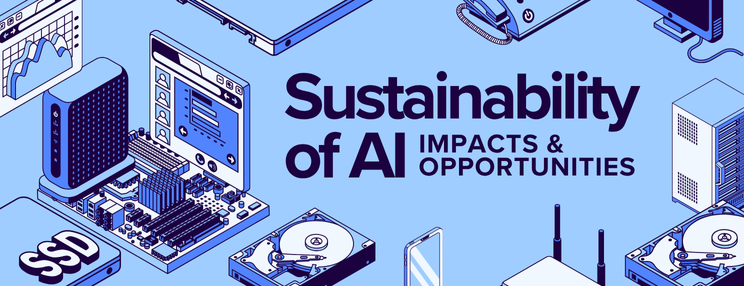Sustainability of AI—Impacts and Opportunities

The rise in popularity of Artificial Intelligence (AI) has generated significant buzz around the impacts on the job market, privacy, innovation, education, and more recently, the environment. Businesses, innovators, and the federal government have been optimistic about and quick to integrate AI, but the general American public is more hesitant. Locally, Wisconsinites have expressed concerns surrounding Meta’s incoming data center in Beaver Dam because of the lack of regulations on these centers’ environmental impacts.
Environmental Impacts of AI
The data centers to house the hardware for complex AI models are temperature-controlled buildings which consume huge amounts of energy and water. This creates strain on the electric grid, increases carbon emissions, drains local water supply, and disrupts surrounding ecosystems. Experts raise concerns that the demand for data centers cannot be met sustainably, so they would be relying on fossil fuel-based power plants for most of their energy.
To put it in perspective, a single ChatGPT query uses around 10 times the energy of a regular web search. Annual projected energy consumption for ChatGPT could power 21,602 U.S. homes for one year. This would create carbon emissions equivalent to consuming over 10 million gallons of gasoline. Globally, ChatGPT’s water usage is the same as the whole of Taiwan flushing their toilet at the same time.
Additionally, AI servers and applications usually require high performance hardware, increasing demand for semiconductor “chips,” small computer circuits with a variety of necessary functions. Chips are made with certain rare earth materials that must be mined, which destroys habitats, contaminates water sources with toxic waste, and pollutes the air. Chips rely on hazardous chemicals in the production process, creating contamination when they’re made and again when they’re disposed of. Because they have a relatively short lifespan, the increase in demand creates a problem with the increase in electronic waste.
Opportunities with AI
There are many strategies to make AI more sustainable without stifling innovation. For one, AI models could be optimized to be more energy efficient in how they’re trained to use fewer resources. Certain accelerators, a component that offloads specific computation tasks to increase efficiency and performance, offer potential energy savings instead of leaving all the processing work to the system’s GPU. An especially important strategy is switching AI data centers to renewable energy sources, like solar panels, instead of fossil fuels they currently rely on to meet increasing demand.
Some argue that there’s also potential for AI to be used to help sustainability initiatives. When combined with real-time data, AI could be used to identify operational inefficiencies regarding a business’ HVAC system, leading to energy savings. AI could also be used to sort through data storage and determine what can be discarded, which would save energy used to store it. Certain industries are using AI for machinery models to predict maintenance and errors without the material waste of multiple physical prototypes.
Ultimately, AI is not going away for the foreseeable future and is likely to expand into all industries regardless of public opinion. The key, seemingly, will be regulating this expansion for safe and responsible AI use without slowing innovation, while also limiting environmental impact of businesses. AI has the potential to accelerate sustainability efforts or greatly counteract them.
Sources
Meta To Build 30th Data Center In Wisconsin | Data Centers | BusinessFacilities.com
Greenhouse Gas Equivalencies Calculator | US EPA
How Much Energy Do Google Search and ChatGPT Use? – RW Digital – Vancouver Digital Marketing Agency
ChatGPT Energy Consumption Visualized – BEUK
Explained: Generative AI’s environmental impact | MIT News | Massachusetts Institute of Technology
Q&A: Can artificial intelligence growth and sustainability go hand in hand? | Penn State University
Achieving a sustainable future for AI | MIT Technology Review
ABOUT PLACON
Since 1966, Placon has been a leading designer and manufacturer of innovative and sustainable plastic packaging for medical, food, and consumer goods markets. Placon has manufacturing operations in Madison, WI; West Springfield, MA; Elkhart, IN; and Plymouth, MN, and is currently ranked in the Top 20 in Plastics News 2024 Thermoformers Rankings. Placon delivers packaging breakthroughs that inspire better engagement between people and products.




